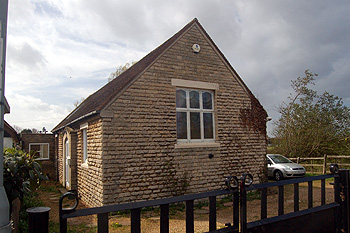Harrowden Methodists
![South elevation of 1933 showing the proposed extension to the left [RDBP2-329]](/CommunityHistories/Harrowden/HarrowdenImages/South elevation of 1933 showing the proposed exten.jpg)
The south elevation of 1933 showing the proposed extension to the left [ref: RDBP2/329]
The Wesleyan Methodist chapel at Harrowden, on the High Road just north of the junction with Old Harrowden Road, opened in 1904. It originally formed part of the Bedford Saint Mary Circuit until 1942, then the Bedford South Circuit until the chapel closed in 1969.
The Rating and Valuation Act 1925 specified that every building and piece of land in the country was to be assessed to determine its rateable value. Eastcotts, like most of the county, was assessed in 1927 and the valuer visiting Harrowden Chapel [ref: DV1/C280/72] found it stood in 0.055 of an acre.
In 1932 the Wesleyan, Primitive and United Methodists, hitherto different churches, came together to form the Methodist Church of Great Britain. In some villages where there was both a Primitive and a Wesleyan chapel one of them soon closed to cut cost. As there was no other Methodist chapel in the vicinity, Harrowden continued under the new branding. The following year a new extension was built [ref: RDBP2/269 and 329].
![Plan of 1933 showing the proposed extension to the left [RDBP2-329]](/CommunityHistories/Harrowden/HarrowdenImages/Plan of 1933 showing the proposed extension to the_351x230.jpg)
Plan of 1933 showing the proposed extension to the left [ref: RDBP2/329] to see a larger version please click on the image
By 1969 there was contemplation that the chapel might close MB1521] and, in answer to a query by the Circuit Minister Bedford Rural District Council stated that conversion to a private house would be preferable to any other use. In answer to a query as to whether it was necessary to officially close the chapel, rather than just cease having services the District Home Mission Secretary wrote: “I was rather worried by the request as something similar happened at Dagnall [Buckinghamshire] in the Dunstable Circuit – and now it has fallen down without anybody ever asking permission to close it! The trouble is that permission to cease services is given without permission to close and nobody has yet invented a form for this, so the records get lost and the “new super” [superintendent] years later finds himself clearing up a complicated situation”. A form requesting permission to close was enclosed with the letter!
The application for closure noted that average attendance at the chapel was now just three or four people. In answer to the question “is it in a dying village” the answer was given: “No. Just sitting at the side of a main road – it is not really in any village”. Consent for closure was given on 2nd July 1969. It was the discovered that by the original deed of 1905 in which Samuel Whitbread conveyed the property the land should revert to the Whitbread Estate in the event of closure.
In 1970 the Bibleway Church of Lord Jesus Christ World Wide in Bedford made an offer for the building for the use of the Bedford West Indian community. It is frustrating that the correspondence ends before the issue of the building’s future was resolved but by 2011 the building was a private house.
In 2013 the property was for sale. The particulars [ref: Z449/6/34] listed, on the ground floor: a porch; a sitting room measuring 17 feet 10 inches by 15 feet 4 inches; a family room measuring 14 feet 4 inches by 11 feet 4 inches; a kitchen/dining room measuring 25 feet 5 inches by 10 feet 5 inches; a utility room; a bathroom and two bedrooms measuring, respectively: 11 feet 4 inches by 5 feet 10 inches; 11 feet 8 inches by 5 feet 10 inches. On the first floor was a galleried area, a bathroom, a study area and a bedroom measuring 17 feet 10 inches by 15 feet 11 inches. Outside was a shed.
 The former Methodist Chapel, March 2011
The former Methodist Chapel, March 2011